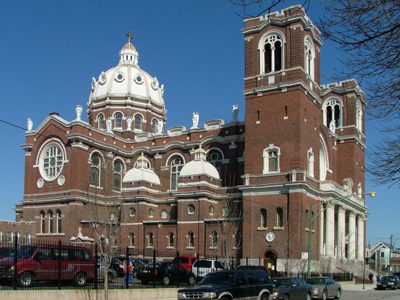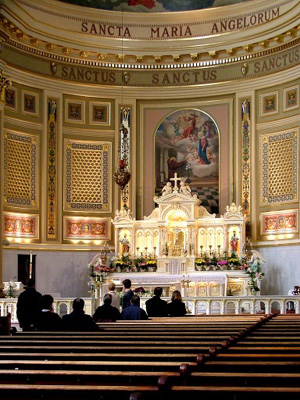 |
|

The church: St Mary of the Angels, Chicago, Illinois, USA.
Denomination: Roman Catholic. This church is administered by the prelature of Opus Dei. Opus Dei was founded in 1928 by Josemaría Escrivá, a Spanish priest who was later canonized. The organization has approximately 85,000 members in 80 countries. Its stated aim is to spread Christ's universal call to holiness by encouraging Christians to live consistently with their faith in the middle of the ordinary circumstances of their lives. But critics have described Opus Dei as a secretive, authoritarian cult, especially because of its practice of mortification of the flesh, and have connected it with right-wing and fascist organizations worldwide. The prelature's existence became widely known through its mention in the popular contemporary novel The DaVinci Code.
The building: This renaissance revival building was completed in 1920. Twenty-six nine-foot-tall statues of angels ring the parapet of the building. The church was slated by the archdiocese for demolition in 1988, but then Opus Dei assumed administraton of the parish and began restoration work on the building in 1991.
The church: The congregation seemed identical to that of any other city parish of originally Polish heritage, which is to say it has morphed into a fairly integrated congregation. Masses are offered in Polish and Spanish as well as English. The conservative viewpoint of Opus Dei wasn't all that evident in the worship except in our remembering St Josemaría.
The neighborhood: The Bucktown-Wicker Park area of Chicago, originally an enclave of eastern European immigrants, has become more diverse and gentrified over the last 20 years. Blocks of worker cottages and century-old three-flat buildings are commingled with new yuppie townhouses.
The cast: The Rev. Hilary Mahaney, pastor, and a cluster of teenage altar boys. The organist and other musical staff were not listed.
Comment: We have received a comment on this report.
Second Sunday of Easter, Divine Mercy Sunday.
How full was the building?
Appeared about one-third full with an impressive 500 or so people at the third mass of the day. My book lists the seating capacity at 1800 but people were smaller in 1920.
Did anyone welcome you personally?
An usher in suit and red sash handed me a parish bulletin.
Was your pew comfortable?
Nice old pews, well-used.
How would you describe the pre-service atmosphere?
It was as quiet and reverential as could be expected in such a reverberant interior. Many families seemed eager to see each other and share words about the death the previous day of Pope John Paul II.
What were the exact opening words of the service?
"Good Morning. Today is Divine Mercy Sunday. Let us pray for the Holy Father."
What books did the congregation use during the service?
The paperback Seasonal Missalette and the Worship II hymnal.
What musical instruments were played?
The original and still-functioning Kimball pipe organ and a violinist accompanying a four-voice (or so) choir at microphones in the balcony.
Did anything distract you?
Dome, transepts, murals, statues, stained glass, and crying babies (in excellent acoustics) all contributed to a healthy level of distraction.
Was the worship stiff-upper-lip, happy clappy, or what?
Neither. I expected a more conservatively traditional service, but got standard contemporary Roman Catholic worship. There was no incense, minimal procession, very little bobbing and crossing, not one lady wearing a chapel veil. They did use bells at the consecration, though.

Exactly how long was the sermon?
9 minutes.
On a scale of 1-10, how good was the preacher?
7 – Father Mahaney was clear and well organized and got the job done.
In a nutshell, what was the sermon about?
Father preached on the Gospel of the risen Lord appearing to the disciples and to the doubting Thomas. He then continued on to the passage: "Whose sins you forgive are forgiven them, and whose sins you retain are retained." This was fairly easily connected to the passing of Pope John Paul II the previous afternoon, his impressive papacy, and the doctrine of apostolic succession.
Which part of the service was like being in heaven?
Perhaps due to the death of the Pope, there was a very tender and welcoming atmosphere in the place.
And which part was like being in... er... the other place?
The music and worship were perfunctory and unengaging. That usual culprit, the throw-away missalette, wasn't much improved on by the hymnal, which contained only the melody lines. Neither Hyfrydol, the opening hymn, nor the closing hymn (which I can't remember) was deemed worthy of singing all the verses. The mass parts were not listed, and the psalm response was just enough different from that in the missalette to confuse thoroughly an amateur singer trying to follow along.
What happened when you hung around after the service looking lost?
Well, no one said a word to me, except a woman asking when the next mass started. There were a large number queued up to get into a confessional prior to the 12.30 mass.
How would you describe the after-service coffee?
Following the crowd out, I made an interesting discovery by following some signs that read "this way" with arrows. There was not just a coffee hour, but a full lunch served in the basement. The bulletin noted that this was today only, as a Polish tradition. I was served ham, deviled eggs, salads and pastries, as well as coffee. On the tables were some butter lambs – butter molded in the shape of a lamb, an old European Easter tradition. I hadn't seen butter lambs in years. Still no one spoke to me. The basement was full of pictures illustrating the restoration of the church and the background of Opus Dei. I dropped a few dollars into a contribution basket and left.
How would you feel about making this church your regular (where 10 = ecstatic, 0 = terminal)?
5 – It was less scary that I expected given its conservative viewpoint. But I'm neither Polish nor conservative, and I prefer a different style of worship. For someone in the neighborhood, especially with a child in the school, it would be more attractive.
Did the service make you feel glad to be a Christian?
Sure. No mention of The DaVinci Code, no warnings about going to confession before receiving the sacrament, no flagella or hair shirts visible. I felt welcome even if no one said as much.
What one thing will you remember about all this in seven days' time?
The butter lambs, and the fabulous job they did restoring all that terra cotta and polychromed plaster.
| The Mystery Worshipper is sponsored by surefish.co.uk, the internet service provider from Christian Aid. By offering email services, special offers with companies such as amazon.co.uk and smile.co.uk, surefish raises more than £300,000 a year for Christian Aid's work around the world. Click here to find out how to become a Mystery Worshipper. And click here if you would like to reproduce this report in your church magazine or website. Top | Other Reports | Become a Mystery Worshipper! © Ship of Fools 2005 |